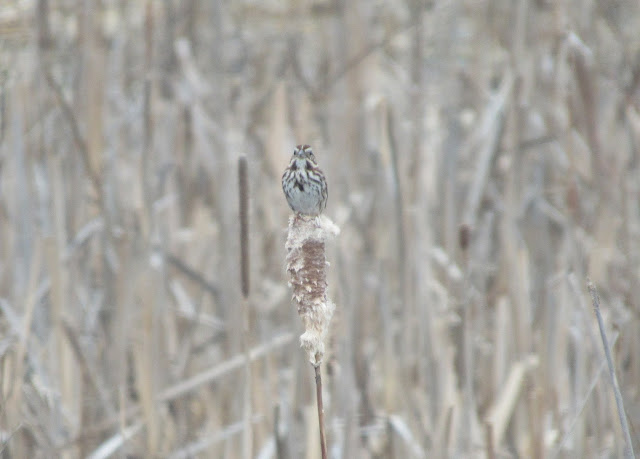I've been learning about a few birding terms for different types of birders. One type is a stringer, and after looking at my records I'm a bit concerned about being called one of these. Basically, a stringer is someone who reports a lot of rarities, but never gets photos of the birds. Furthermore, they usually "call" a bird without considering what else it could be.
Now, there is a local birder considered a stringer in my neck of the woods. Every so often, they will put a list out on Ebird containing some very unlikely birds in unlikely places. For instance, they claim to have seen a Glaucous Gull in my county, but they reported it as being in the woodlands across the road from Lick Creek Wildlife Area. Glaucous Gulls are rarely found on the biggest lakes and rivers in Illinois, and pretty much nowhere else in this state. There's close to zero chance that it was found where they said it was.
I have a few bad records on Ebird that I've decided to clean out (a report of 8 Grasshopper Sparrows from September 2016, for instance, when I only saw two of them clearly, and a report of a Whip-poor-will in flight that I can only put down to stupidity.) I put these back when I didn't know better. I am still fairly new, but I'm learning quickly.
Here's a fuller discussion of what a stringer is: http://blog.aba.org/2014/05/on-stringing.html
Now, I found the only Common Redpoll seen in central Illinois this winter. After that it was a Prairie Falcon, a few days after the only confirmed sightings. The eBird reviewers didn't like that at all, and that Prairie Falcon rests in sighting purgatory. Since I haven't "legally" seen the Prairie Falcon, I will have to look for one in the future. Then I found the only Pine Siskin in Central Illinois in 2017 (apart from a couple of records in east-central IL). I got no photos, but since it was on my birdfeeder, I was able to identify it well. At the end of March, in a repeat performance of the Common Redpoll's sighting, I found a Harris' Sparrow. Again, it was sitting in a bush, and ducked down and away before I could get a photo. This lack of photos and rarity of the sightings has me concerned that people might think I'm making them up.
The reason I found the Harris' Sparrow in the first place was simple- I wanted to find a Loggerhead Shrike. Several birders had seen one here the day before, so I hoped to get lucky and find it. I didn't, but I did find the Harris' Sparrow, a bird of the Great Plains occasionally found in Illinois.
A few miles away, I found a small prairie pond with Greater Yellowlegs (Tringa melanoleuca), though remarkably no frogs were calling. A Song Sparrow (Melospiza melodia) was singing away:
At this point, it's time for my second vocabulary word of the day- twitcher. This is British English for birder (though especially the kind I'm about to describe), but on this side of the pond it's specifically used for a particular kind of birdwatcher. Another word, from American English, is chaser. This would be the sort of birder who sits about reading Ebird database lists and Facebook posts, until a great rarity is spotted. At that time, they drive up to hundreds of miles away after one bird, see it, mark it on their list, and return home.
I decided, in the middle of Mason County, to become a twitcher, at least for the day. I'd heard about a very rare duck in Arcola, and I decided to drive all the way out to Arcola after it. If you're unaware of Illinois geography, and a great many people are, Mason County is in the middle of Illinois. Arcola is two hours southeast, plus an hour and a half's drive home. For a duck.
I too blame temporary insanity.
There were lots of ducks in the marsh, and as I hurried out of the car, I left my camera batteries inside. It was a bit of a walk back to the car, and I didn't particularly feel like walking back to it.
THIS WAS A MISTAKE!
Apparently my camera was on its last legs in terms of electrical power. I didn't realize this until I went to take a photo. For ducks, I use my camera as a scope, allowing me to zoom in and look through a group of ducks- and record them at my leisure for future. This wouldn't work with dead batteries. I wouldn't have kept going, but I saw another car parked at the entrance, and I hoped to find another birder who had eyes on the Cinnamon Teal.
Thanks to that birder, Benjamin Murphy, and his scope, I soon had eyes on the Cinnamon Teal (Anas cyanoptera), the orange duck on the right above. Now, while I can't fully explain why I decided to go and see this duck, I'll tell you why this duck was seen by many birdwatchers. To put it simply, Cinnamon Teal are usually found in the West, and I mean the Rockies. They're only found on the Great Plains during migration. They slip over to Illinois every so often, but it's a fairly rare bird nonetheless! You can see it much better below:
I then drove home, elated by my finds. In addition to the Harris' Sparrow and Cinnamon Teal, I'd also found an American Pipit, giving me my third lifer bird (bird I've never seen before) of the day. I got out of the car (finally- that car isn't meant to be driven on country roads for hours on end!) and pondered why I had driven all that way after one bird. I haven't figured it out since, and for now I'm just calling it obsession.







No comments:
Post a Comment